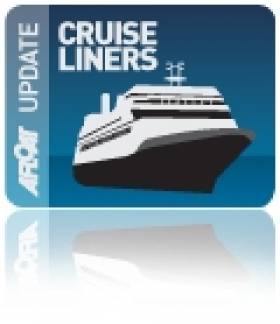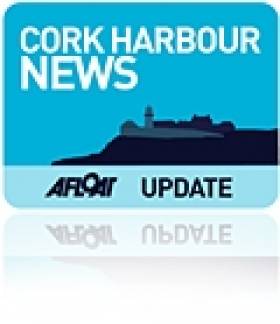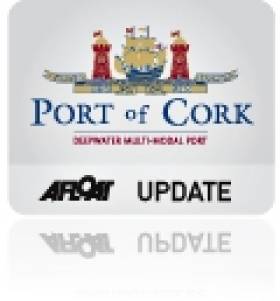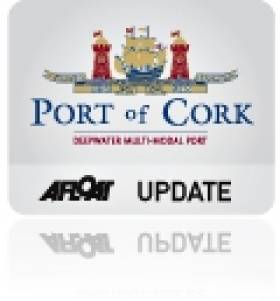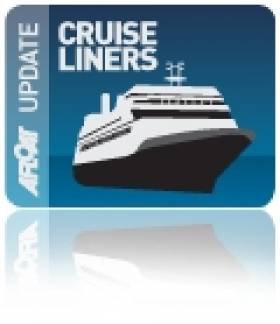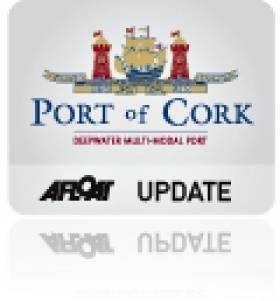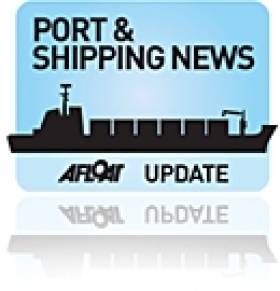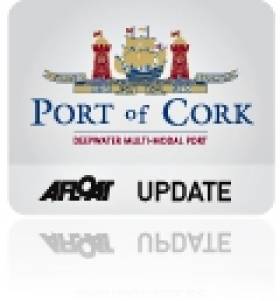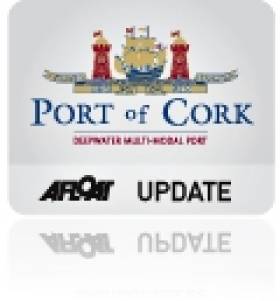Displaying items by tag: port of Cork
Cruiseship Trio Head for Cork Harbour
#CorkCruiseCalls – The Port of Cork will be busy tomorrow as three cruiseships capable of carrying a combined total of 4,200 passengers are to visit the natural harbour, writes Jehan Ashmore.
First to make an entrance will be Celebrity Infinity followed by AIDAcara, a recent caller to Dublin Port and making up the trio, Club Med 2, which too called to the capital port today.
AIDAcara is to berth alongside Cobh Cruise Terminal while the other pair are due to dock at the Ringaskiddy Deep Water Berth.
As previously reported, the cruiseship sector is worth more than €40 million annually to the Cork economy.
August is the busiest month for the Port of Cork cruise season and by the end of this month the port will have welcomed 21 cruiseships alone and carrying up to 30,000 passengers.
By the end of the season, more than 60 cruiseships will have visited.
#Members of the public, former employees of Verolme Cork Dockyard in Cobh, Cork Harbour, their families are being invited to take a trip down memory lane and to remember the glory days of shipbuilding in Cork on 24th and 25th August 2013. Verolme Cork Dockyard employed over 1200 at its peak and closed in 1984, although ship repair is still carried out on the site. Cobh Tourism Ltd and a small committee have been planning this Gathering Ireland 2013 event for several months and have put together a comprehensive programme of events.
An opening ceremony will be held on Saturday 24th August at 11 am in the Promenade in Cobh followed by a series of shipping related lectures in the Commodore Hotel from 1 pm to 6 pm that are sponsored by Cobh Town Council and the Commodore Hotel.
The lectures will be on the Irish Naval Service by Cmdr. Steve Walsh, Irish Shipping Ltd – The First Fifteen Ships by the Rosslare Maritime Enthusiasts, Launching of a Ship by John Brennan, Heavy Lifting Platforms by Capt. Pat Murphy, Port of Cork and the History of Port of Cork by Capt. Pat Farnan.
From immediately after the lectures on Saturday there will be an informal social evening in the Commodore Hotel, commencing with a performance by local sea shanty group Molgoggers.
Also on Saturday there will be free tours of the VCD built Naval Patrol Vessel LE Aoife from 2 until 5 pm at the deepwater quay.
A photographic exhibition of close to 200 photographs covering all aspects of the development of the yard, the ships built and repaired, the many other projects completed and the people working there will be staged at Cobh Heritage Centre. This exhibition is generously sponsored by the Port of Cork and will run until 15th September. Admission is free.
Former dockyard workers and their families are invited to the official opening by Capt. Michael McCarthy on Thursday 22nd August at 6 pm.
On Sunday morning at 10 am there will be a remembrance mass in St. Colman's Cathedral and the baptismal font that was made by dockyard workers in 1970 and recently refurbished by former dockyard workers will be rededicated.
The unveiling of a Memorial at Cork Dockyard to all those who worked in the yard will take place at 11.45 am and this is open to everyone. From 12.15 until 4 pm there will be ongoing free guided tours of the yard and this will be a once in a lifetime opportunity for former workers and their families to take a trip down memory lane.
As parking in the vicinity of the yard is limited, people are encouraged to take the train to Rushbrooke from either Cobh or Cork as so many employees did in the past. On Sunday trains from Cobh leave at 11.30, 12.30, 13.30, 15.00, 16.30, 17.30 and 18.30.
Trains from Kent station, Cork depart at 11.00, 12.00, 13.00 and 14.30.
The cruise liner Balmoral will be berthed in Cobh from lunchtime on Sunday, adding another family friendly activity to a town that is packed with things to see and do.
Cork Port First in Ireland for Sea-Fi Network
#Sea–fi– Following a successful trial period, the Port of Cork has announced details of their partnership with Ringaskiddy based company Sea-Fi Marine Data Communication Ltd. Sea-Fi is a wireless network covering the navigational areas of Cork Harbour, and up to 10 Km off Roches Point and over the last six months Sea-Fi have provided Wi-Fi on board the Port of Cork owned vessels, MV Denis Murphy and MV Gerry O'Sullivan.
This has proved very successful, allowing the work vessels send and receive emails, images and work reports from around Cork Harbour. It has also proven a time and money saver, eliminating the need for the work vessels and crew to go back to base for administrative purposes, as this can now be completed on board.
The partnership between the Port of Cork and Sea-Fi will see the roll-out of SeaFi Horizon™ WiFi for all visiting commercial vessels either sailing or on anchor inside and outside Cork Harbour. This is the first port in Ireland to have a fully operational Sea-Fi network.
Speaking about the partnership, Port of Cork Harbour Master, Captain Paul O'Regan said: "Following the successful trial period on board our tug and work-boat we are very pleased to announce this partnership with local based company Sea-Fi. Currently many commercial vessels using the Port of Cork use the internet via their on board sat-coms. Offering a Wi-Fi service will mean they have a more efficient service when transferring large data and faster download speeds which means cost savings for the ships equipped with a SeaFi Horizon™ ship station."
He continued: "Very often some crew have no access to the internet while in a port, but now with Port of Cork SeaFi Dockside™ service, crew will be able to access their emails, call their family with Voice over IP (VoIP) which will greatly improve crew welfare."
Initially this partnership will see the SeaFi Dockside™ being rolled out at Ringaskiddy Deepwater Berth, Tivoli Container Terminal and Cobh Cruise Terminal. This is not a marina style Wi-Fi network, but a highly advanced system capable of transferring large amounts of data, if required.
It is proposed in the future to roll out a similar service which would be offered to leisure craft using Cork Harbour.
Heritage Day 2013: Port of Cork HQ Tours & 'Seascapes'
#HeritageDay – Heritage Day 2013 is next Saturday 17 August and marks the start of National Heritage Week which runs to the 25 August.
As part of the Heritage Day, there will be an illustrated talk by RTE Radio 1 Seascapes presenter/ producer Marcus Connaughton.
The talk will be about the maritime heritage of our seafarers and maritime explorers who sailed the World's Oceans. "Maritime Heroes of An Island Nation- featuring Edward Bransfield; Tom Crean; Admirals Barry and Brown; John Philip Holland; Shackleton and many others."
This FREE event will commence at 2pm in the Port of Cork Boardroom, should you wish to attend, bookings can be made by contacting Sara Mackeown on (021) 462 5375.
On the same day the Port of Cork's Custom House Building will be open to the public between 11am – 4pm. Note, there is no parking available.
First of Five Double Cruise Caller Days
#CruiseDoubles – As previously reported earlier this week, August will be the Port of Cork's busiest month ever with 21 cruise liners alone scheduled to call, starting with the visit today of the ultra-luxury Sea Cloud and a double call tomorrow, writes Jehan Ashmore.
In total up to 30,000 cruise passengers will step ashore during the month bringing a welcome boost to the local economy. On five days throughout the month, there will be two cruiseships calling on the same day starting with HAL's Veendam and Saga Cruises relative newcomer Saga Sapphire.
Take a tour of Saga Sapphire with behind the scenes clips which includes farmers Ian and Lesley Buxton who have created more than a dozen 'Fusion Flavoured' ice-creams especially for the cruiseship's East to West restaurant.
On the 29 August the Port of Cork is to welcome not just two callers but three cruiseships visiting the harbour with calls to Cobh, Ringaskiddy and also involving an anchorage call off Whitegate.
Port of Cork Improves Performance in 2012
#portofcork – The Port of Cork Company have today announced their annual results for 2012 and despite the on-going national economic downturn; the port returned an improved performance in 2012 compared to 2011.
Total traffic in volume terms amounted to 9.05 million tonnes, against a volume of 8.8 million tonnes in 2011. Turnover amounted to €21.8 million, an increase of 1.87% and after deducting costs, the profit on ordinary activities before taxation amounted to €1.36 million.
Commenting on the 2012 annual results, Port of Cork Chief Executive, Brendan Keating said: "We are pleased to announce our 2012 results today which have returned an improved performance compared to 2011."
He continued: "Reliable accessible ports delivering prosperity is vital to the achievement of economic recovery in Ireland. We see investment in handling equipment and facilities as key to the future of our business and that of our customers and we are intent on growing our business. The Port of Cork is central to a brighter future for the Irish economy because of the value it brings in moving goods to market for both customers and businesses alike."
Throughout 2012, the company maintained its commitment to capital investment by making additions to fixed assets of up to €6 million. This brings investment levels by the company, since incorporation in 1997, to €103 million. Recent achievements in 2012 saw the Port of Cork complete a new compound in Ringaskiddy to accommodate a new Maersk transatlantic service which commenced in January 2012. This is the first Lo-Lo (Lift on Lift off) deep sea service in Ireland. A new dry bulk store at the Deep-water berth in Ringaskiddy was completed by port customer Arkady, which has helped to increase the volume of trade through the port. This will also help to facilitate the growth of the dry bulk sector. In 2012 the Port of Cork also took delivery of a new pilot boat named 'Failte' and won the business of servicing the Exxon Mobil oil exploration project.
Oil Traffic at Philips 66, Whitegate Oil Refinery amounted to 5 million tonnes, an increase of 1.36%. Non-oil traffic amounted to 3.64 million tonnes showing an increase on 2011 of 6%.
Container traffic through the port increased by 6%, bringing the total volume of containers handled at the port in 2012, to 166,285 TEU. Currently the Port of Cork has weekly container services calling to mainland Europe, Rotterdam, Antwerp, Zeebrugee and Southampton. A deep sea transatlantic container service linking Central America to North West Europe also operates weekly.
While the liquid bulk and container traffic increased, imports of animal feedstuffs also increased. The Port of Cork anticipates further increases in the agri-business, particularly when the reforms to the CAP come into effect in 2015.
In 2012, the Port of Cork welcomed 57 cruise liners, carrying in excess of 100,000 passengers and crew to the region. The visiting cruise liners make a very significant contribution to the economy. The investments made by the Port in recent years developing the cruise facilities in Cobh, continue to show positive returns with booking levels continuing to grow year on year. At the global annual cruise shipping exhibition, Seatrade Miami 2012, the Port of Cork was awarded 'Best Shore Side Welcome' and 'Best Tour Guides'. These awards highlight the commitment and effort the Port of Cork make for every cruise liner calling to Cork.
Brittany Ferries' weekly passenger service from Cork to Roscoff had another successful season operating between March and November 2012. The Port of Cork remains fully committed to establishing new routes from Cork and continues to work to develop a route from Cork to Northern Spain.
Consistent with the Strategic Development Plan Review of 2012, the Port of Cork is planning for the delivery of new Port infrastructure in the lower harbour. This key infrastructure will be required to service the businesses of Ireland for the next 20 years, as they grow and prosper and avail of trading opportunities in global markets. In 2012, by way of planning for this infrastructure, the port carried out a consultation process with An Bord Pleanála. Following the recent publication by Government of the National Ports Policy Statement, in which the Port of Cork was highlighted as a Tier 1 port of National Significance, it is hoped that such recognition will help to accelerate the consultation process. The Port of Cork proposes to lodge a planning application with An Bord Pleanála by the end of 2013, following further public consultation and community engagement.
During 2012, the port was involved in a number of local community based projects in Cork Harbour. Additionally, the very successful schools initiative organised by the port, continues to grow. Now in its seventh year, the initiative attracts up to 20 primary schools from the Cork city and harbour area and helps raise awareness of the Port of Cork and Cork Harbour among 5th class children.
Sustaining the quality of the environment in Cork Harbour, particularly in areas which have the potential to be affected or influenced by Port Operations remains a priority for the Company. The Port of Cork is as always committed to the highest standards of environmental management through the implementation of the environmental management programme and standards consistent with the renewed ISO14001 accreditation and Eco Ports foundation.
Cork Stamp Celebrates Cork Harbour and Port of Cork
#portofcork – An Post and the Port of Cork Company unveiled a new postage stamp collection today (Wednesday 17th July) celebrating the Port of Cork and Cork Harbour.
The three stamps, designed by Steve Simpson, feature MV Queen Elizabeth berthed at Cobh Cruise Berth, Ireland's only dedicated Cruise berth, a Maersk Vessel carrying large containers of bananas into Ringaskiddy Deep-water berth and the Cork Clipper yacht racing past Cobh as part of the Clipper race in 2010. Collectively these stamps celebrate Cork Harbour and highlight its importance as a commercial port, a cruise destination and a beautiful leisure amenity for everyone to enjoy. The Port of Cork has been for many years the main trade link for the south coast of Ireland and today the Port remains a vibrant busy port, facilitating the movement of imports and exports. The Port of Cork is a key link to the continued economic success of Ireland and in particular the entire Munster region.
Speaking at the postage stamp launch in Custom House, Mr Brendan Keating Port of Cork Chief Executive said: "This is a great honour for the Port and indeed Cork Harbour, to be featured on An Post's latest postage stamp collection. These stamps will not only raise awareness of the Port of Cork locally and nationally, but once posted these stamps will begin to make their way around the world, which is super recognition for Cork."
He continued: "I'd like to thank all those involved in the process and particularly the An Post design team for producing an excellent collection of stamps of which we are very proud."
The Port of Cork stamp set and accompanying First Day Cover and Miniature sheet set will go on sale nationwide immediately. They can also be ordered at irishstamps.ie or by calling 01-7057400.
To coincide with the launch of the stamps, the Port of Cork also announced the winner of their Photograph Competition themed 'Cork Harbour – A Port in Focus'. Tony O'Driscoll from Cobh, Co. Cork was the overall winner and to mark his achievement his photograph was designed into a postcard. Today the postcard was unveiled with the stamps attached, all ready for posting. There were over 130 photographs received for the competition, which greatly exceeded the Port of Cork's expectations.
Mr Keating congratulated the winner and thanked all those who took part in the photograph competition.
Ports & Shipping Review: Container Rates 17 Month Low, €3m Port of Cork Crane, Dry Bulkers Price Rise and EU's Blue-Belt
#ShippingReview: Over the last fortnight Jehan Ashmore has reported from the shipping scene where container market rates are unlikely to drop any further following average global rates falling to a 17-month low last month.
Port of Cork Company are to invest €3 million in new mobile crane plant equipment for the Ringaskiddy Deep-water Berth.
Rising prices for second-hand dry bulk vessels point to a turnaround in the industry.
The European Commission launched the 'Blue Belt' communication, which contains two concrete proposals that will contribute to establishing an internal market for maritime transport.
Port of Cork All Set for Australia Day in Cobh
#SydneyWorldCruise – Tomorrow is Australia Day and the Port of Cork will welcome up to 1500 from Down Under as well as 400 Kiwis to Cobh as part of their Sydney to Sydney World Cruise on board Princess Cruises Sea Princess.
As the passengers step ashore from the 77,499 tonnes vessel's maiden voyage to Cobh, they are sure to receive a very warm Irish welcome as Cobh Tourism presents Australia Day with the weather forecast to match.
In the morning when Sea Princess arrives there will be a formal port welcome on board to the Captain attended by Port Management and the Australian Ambassador to Ireland Dr. Ruth Adler.
Following this, there will be a civic welcome ashore with the Captain and Cruise Director of Sea Princess and the Australian Ambassador at 11.30 am in Cobh Heritage Centre, adjacent to the quayside.
With such a rich and poignant history of emigration from the Port of Cork, particularly from Cobh (formerly Queenstown) to Australia, this "special Irish Australia Day" will not only mark the visit of this spectacular cruise liner but will also remind visitors of the thousands who left or were deported from Ireland bound for a life down under. With this in mind, a "Blessing of the Bonnets" ceremony will take place in memory of all convict women transported from Ireland to Australia.
Captain Michael McCarthy, Commercial Manager Port of Cork has for some time being working with Princess Cruises to secure the call of Sea Princess on her world cruise. With so many Australian roots here, the Port of Cork was thrilled when they received confirmation that the World schedule included Cobh.
Of the 60 cruise liners calling to the Port of Cork in 2013, 11 vessels carry the very distinctive brand of Princess Cruises and they alone will bring over 30,000 visitors to Cork Harbour and its regional attractions. In addition, August is set to be one of the busiest months on record for the port, with 21 liners calling.
With so much happening in Cobh on Sunday, cruise passengers and visitors to Cobh are set to have a fantastic day with local traditional music and dance, fascinating Australian themed shop window displays, sizzling barbecues, food stalls and local arts and crafts stalls on display.
A performance by the Band 1 Southern Brigade will take place at 2.30 pm in the town park and will be followed by more local entertainers. Captain McCarthy stated that "the tremendous work undertaken by Cobh Tourism and the team spirit of all organisations and Councils working together has put Cobh and the entire Cork region a "must see destination" on the cruise companies calendar.
The Cobh Confraternity Brass and Reed Band will play on the quayside as the Sea Princess sails to continue its 104 night odyssey around the World.
Will the traditional "Anchors Aweigh" be replaced by "Tie Me Kangaroo down Sport" as 2000 happy passengers are given a traditional Cobh farewell with white handkerchiefs and Australian and Irish flags waving.
#PortofCork - Plans to start a new Motorway of the Sea between Port of Cork and Gijon in northern Spain was called for at the Ireland-Iberia Trade and Transport Round Table forum which was held in Dublin today.
The IEA chief executive calls for a direct sea-freight connection with one of our longest established markets –in Spain- as way to boost the flagging exports to that market.
Last year exports to Spain amounted to €2.9 billion, this is down by €400 million from the €3.3 billion exports in 2007 . There is sufficient volume to support a new direct service to the Iberian Peninsula -- Ireland exported 230,000 tonnes of goods and imported 701,000 tonnes. Currently 110,000 tonnes of goods move between Ireland and Iberia by road with the consequent cost, environmental impact and susceptibility to British and French restrictions on HGV traffic and road-usage charges.
For some considerable time the Port of Cork and Port of Gijon in northern Spain have been working together on the feasibility of setting up and launching a 'maritime motorway' between the two ports by means of a regular, twice-weekly roll-on/roll-of ferry service which would complete the journey in 25 hours and reduce the total time and cost associated with the movement of goods between the island of Ireland and the Iberian Peninsula.
According to Michael McCarthy, Commercial Manager of the Port of Cork "the service will facilitate and enhance the already significant freight and tourist activity between the two regions".
John Whelan, IEA chief executive stated; "The advent of the Irish government's new ports policy together with major investment by Spanish authorities in the Port of Gijon and its 4 million square metre multimodal logistics park ZALIA, and EU incentives to encourage road freight traffic to mode-switch to short sea shipping, have lent considerable extra momentum to this initiative to establish a direct shipping connection between Ireland and Spain.''
The Ireland-Iberia Trade and Transport Round Table hosted by Patrick Daly, Managing Director of Alba Consulting at the Guinness Enterprise Centre on Tuesday 25th June from 1pm to 3.30pm will examine and review developments to date and the opportunities for the future including:
• Updated trade figures by transport mode between Ireland and Iberia.
• Port of Cork infrastructural developments and future strategy.
• Port of Gijon (Spain) developments and future strategy.
• ZALIA intermodal logistics park capabilities and advantages.
• Cork-Gijon RoRo service capabilities and advantages
Executives attending the event in Dublin will include delegates from major Irish importers and exporters such as Diageo, Irish Distillers, PepsiCo Worldwide Flavours, Glanbia, DSV, Celtic Logistics, LTL International among others as well as representatives from the Irish Exporters Association, Port of Cork, Port of Gijon (Spain) and ZALIA Logistics Park (Spain).


























